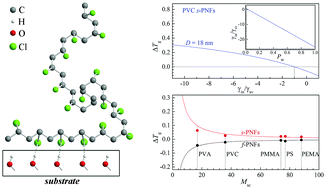Raising glass transition temperature of polymer nanofilms as a function of negative interface energy
Abstract
Based on a thermodynamic approach, glass transition temperature (Tg) of substrate-supported polymer nanofilms (s-PNFs) is investigated for carbon-chain polymers, taking the role of the interface energy into consideration. Relative to the Tg depression, originating from the positive interface energy due to the weak interfacial van der Waals interactions, the Tg raise is reversely induced by the negative interface energy, induced by the hydrogen bonds formed between the side-chains of polymers and the surface hydroxyl groups of substrates. Moreover, the Tg raise can be reinforced for s-PNFs with simple side-chains. The model predictions agree well with available experimental or simulation results.



 Please wait while we load your content...
Please wait while we load your content...